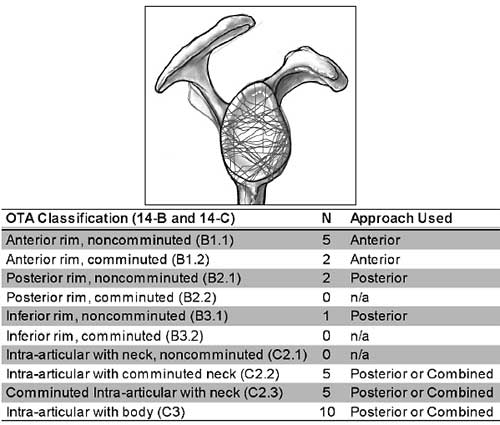
Fri., 10/9/09 Upper Extremity, Paper #48, 11:34 am OTA-2009
Surgical and Functional Outcomes after Operative Management of Displaced Intra-articular Glenoid Fractures
Jack Anavian, MD (n); Coen A. Wijdicks, MSc (n); Lisa K. Schroder, BS, MBA (n);
Peter A. Cole, MD (5B, 7- Synthes; Zimmer; Smith &Nephew; DePuy, A Johnson &Johnson Company; Acumed, LLC; Biomet);
Department of Orthopaedic Surgery, University of Minnesota, Regions Hospital,
Saint Paul, Minnesota, USA
Purpose: It is generally well accepted that operative treatment is indicated for displaced fractures of the glenoid fossa, based on lack of articular congruity and joint stability. However, little is known regarding functional outcomes in these patients. The purpose of this study is to assess the surgical and functional results after treatment of displaced, intra-articular glenoid fractures.
Methods: 30 patients (28 males and 2 females) with a displaced intra-articular fracture of the glenoid were treated surgically between 2002 and 2008. Fractures were classified as partial (14-B) or complete articular (14-C) according to the revised OTA classification (see table). Indications for operative treatment include fracture gap or articular stepoff ≥4 mm, as measured on CT scan. Overlaying of the fracture patterns yielded an illustration of a fracture map for this cohort (see figure).

21 patients had extra-articular scapula involvement of the fracture as well. A posterior approach was utilized in 19 patients, an anterior approach in 7, and combined in 4 (table). Functional outcomes, including Disabilities of the Arm, Shoulder and Hand (DASH) and Short Form-36 (SF-36) scores, range of motion, strength, shoulder pain, and return to work/activities were obtain on 24 patients (80%). Six patients were lost to follow-up.
Results: At a mean follow-up of 23.5 months (range, 6-73 months), all patients had complete radiographic union of their fracture. Mean preoperative fracture gap and stepoff were 8 mm (range, 4-25) and 5 mm (range, 4-12), respectively. Mean postoperative fracture gap and stepoff were 0.5 mm (range, 0-4) and 0.4 mm (range, 0-3), respectively. The mean DASH score at follow-up was 11.9 (range, 0.0-41.9; normative mean, 10.1). For all parameters, the mean SF-36 scores of the study patients were comparable to those of the normal population. 20 patients were pain-free at follow-up and 4 of 24 patients complained of mild pain with prolonged activity. 21 of 24 patients had returned to their preinjury work and activities. Complications included intra-articular screw placement in 1 patient, surgically corrected on postoperative day 2, and postoperative stiffness in 1 patient, requiring manipulation under anesthesia at 6 weeks.
Conclusion: Our data suggest that surgery for displaced intra-articular glenoid fractures with or without involvement of the scapula neck and body can be associated with good functional results and a low complication rate.
• The FDA has not cleared this drug and/or medical device for the use described in this presentation (i.e., the drug or medical device is being discussed for an “off label” use). ◆FDA information not available at time of printing. Δ OTA Grant